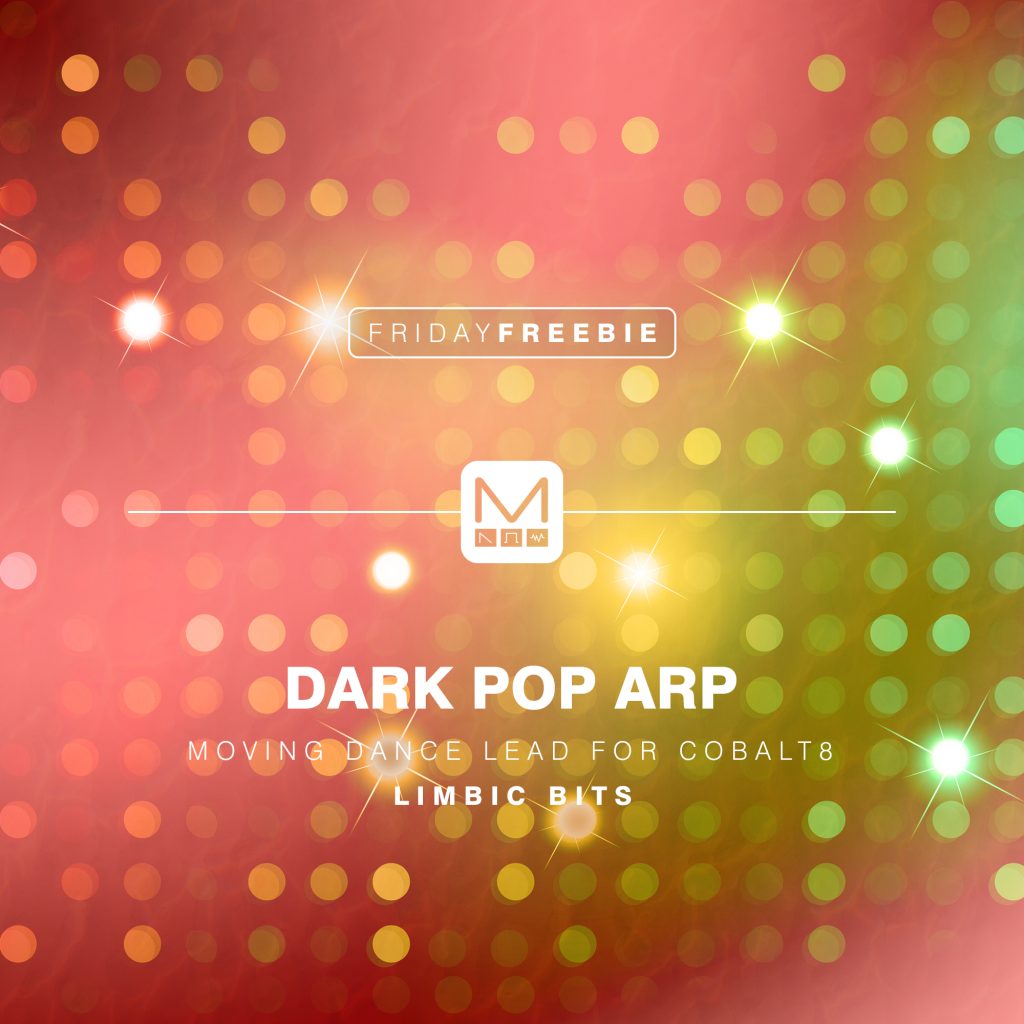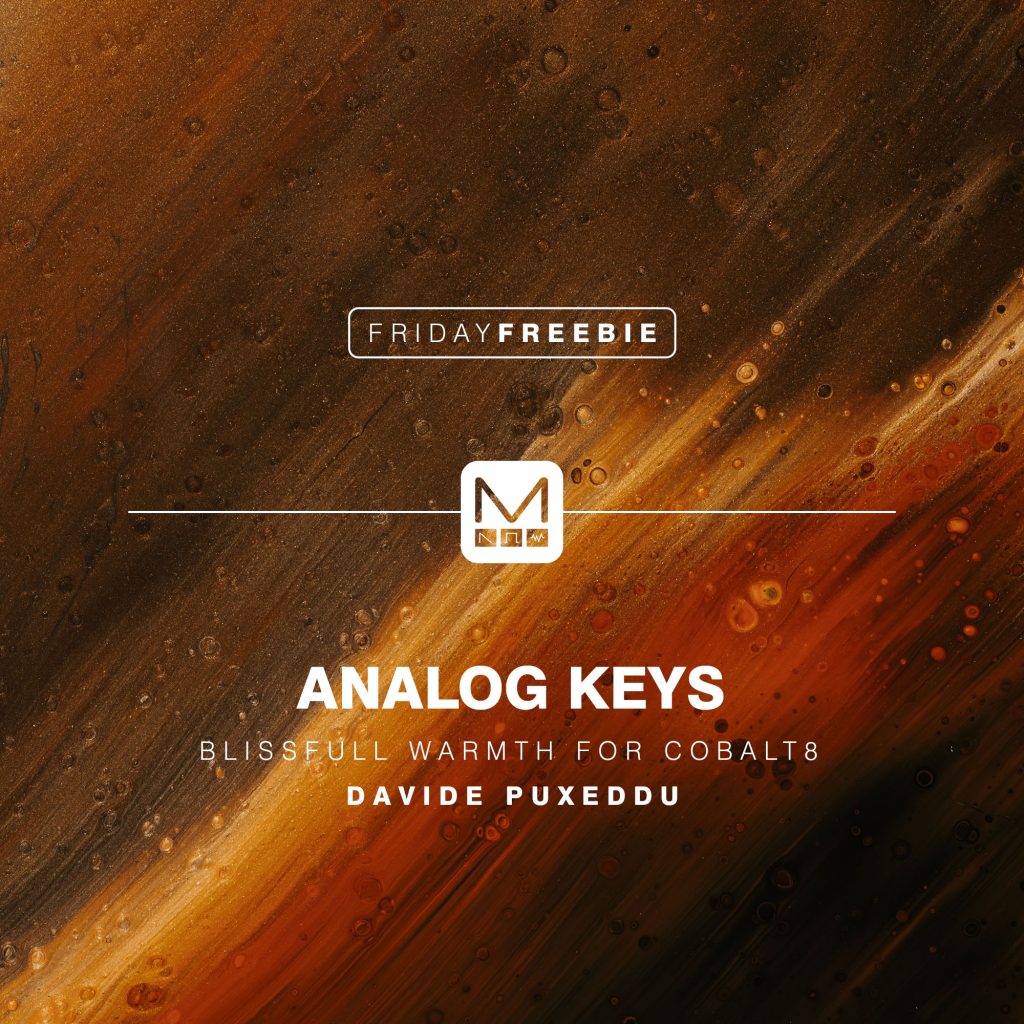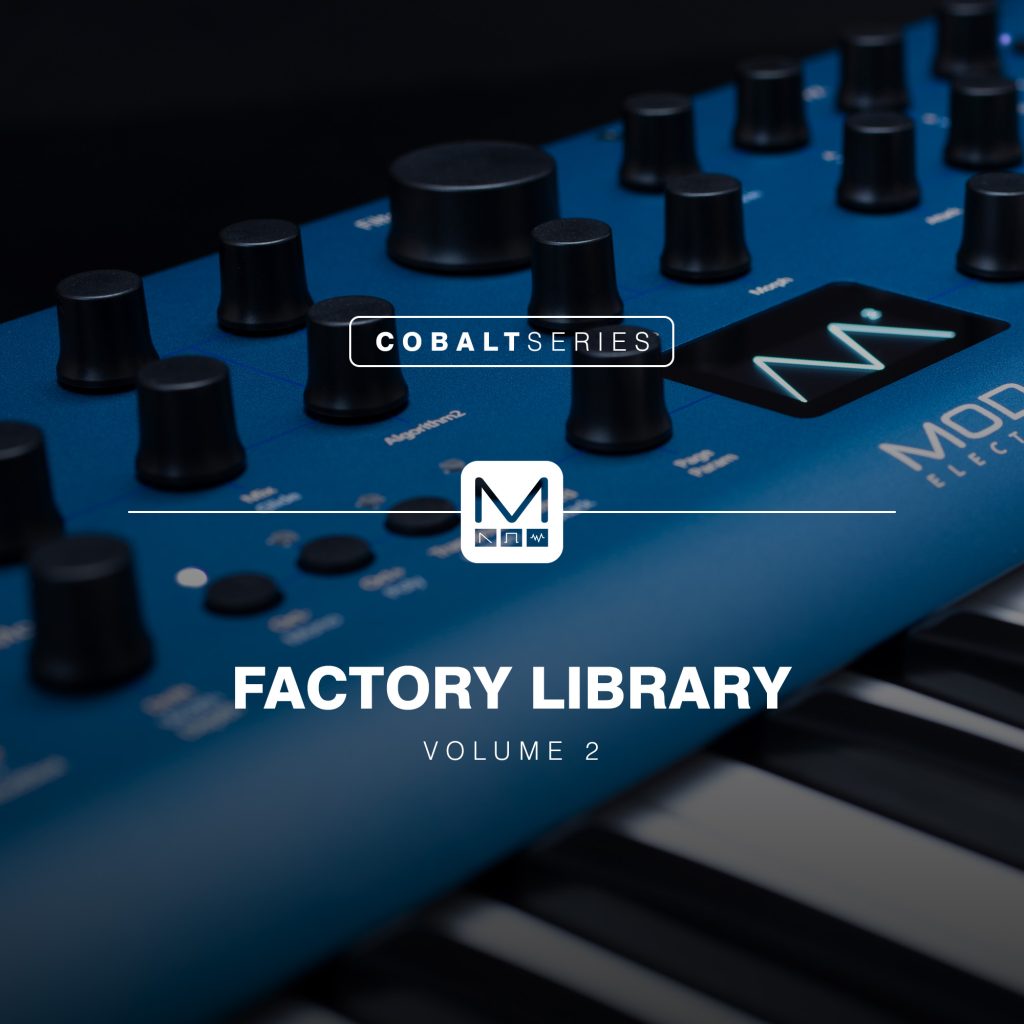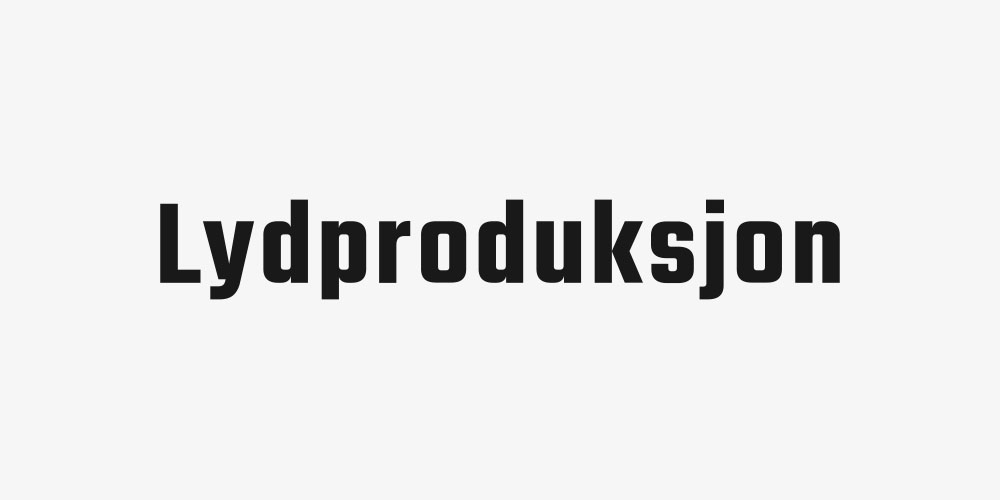This website uses cookies so that we can provide you with the best user experience possible. Cookie information is stored in your browser and performs functions such as recognising you when you return to our website and helping our team to understand which sections of the website you find most interesting and useful.


COBALT8M
8 voice extended virtual-analogue synthesiser
Building on the tradition of warm and punchy analogue-style synth sounds, conceived by legendary synthesisers from the past, COBALT8M unlocks the full creative potential of analogue waveforms. This powerful, inspiring instrument reinvents the aesthetics of analogue sounds and invites musicians, producers and sound designers to explore a new era of virtual-analogue synthesiser textures, far beyond the limits of its analogue forefathers.
On top of the innovative oscillator engine of COBALT8M, we added a massive arsenal of inspiring morphable and static filters. Combined with Modal’s unparalleled modulation options, an inspiring real-time / step sequencer, the energising arpeggiator, MPE, studio-quality effects and MODALapp integration, COBALT8M is the perfect synth for everyone who wants a versatile electronic music instrument to play vintage synth sounds and is eager to enter into new sound dimensions.
Eight true polyphonic voices tempt players to lay out wide string or rich synth pad chords, while a monophonic bass or lead patch, played with 64 oscillators can shake the walls of every stadium. And with the avant-garde sound forming features, every synth enthusiast can refine his performance with sounds that no other synthesiser is able to generate.


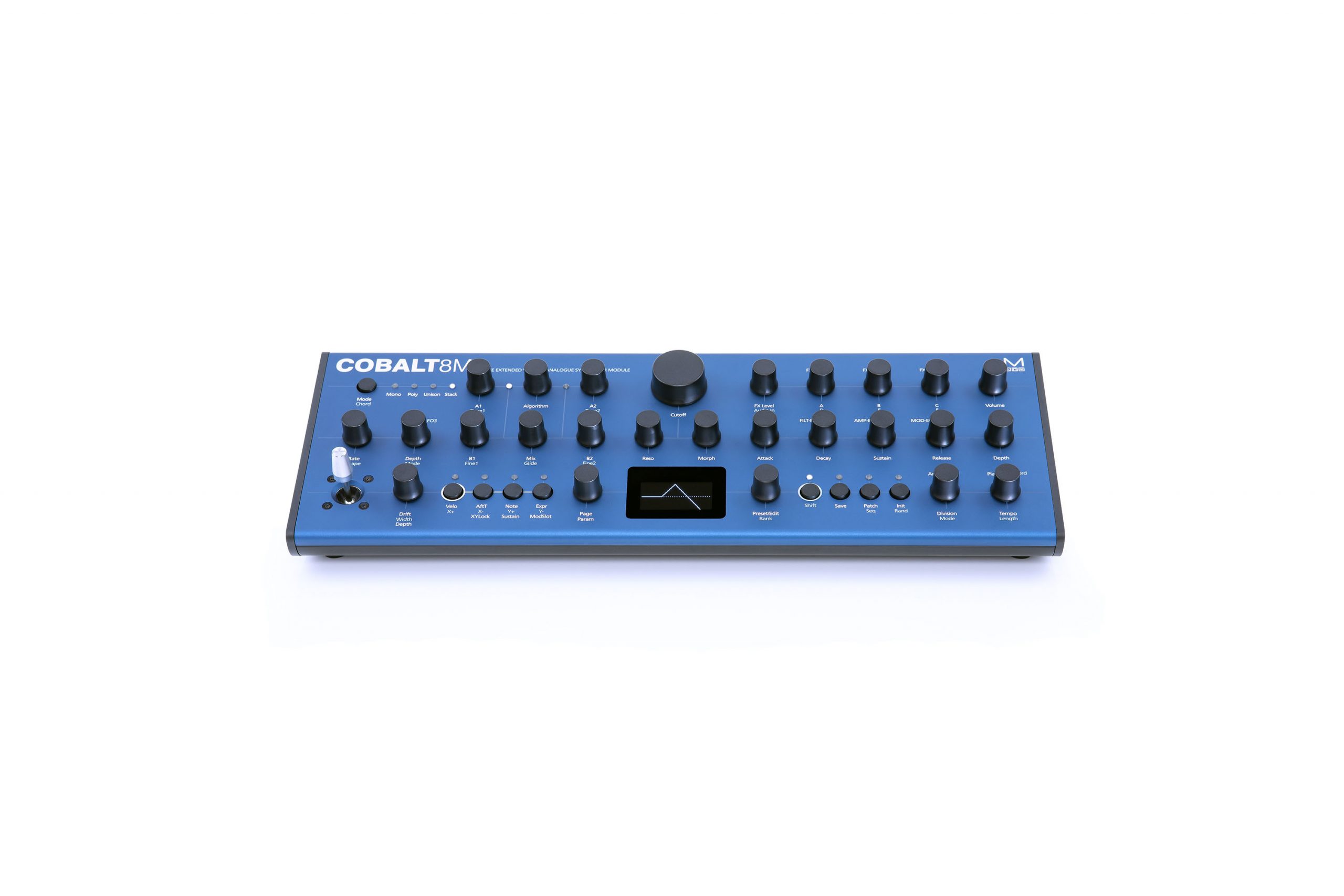
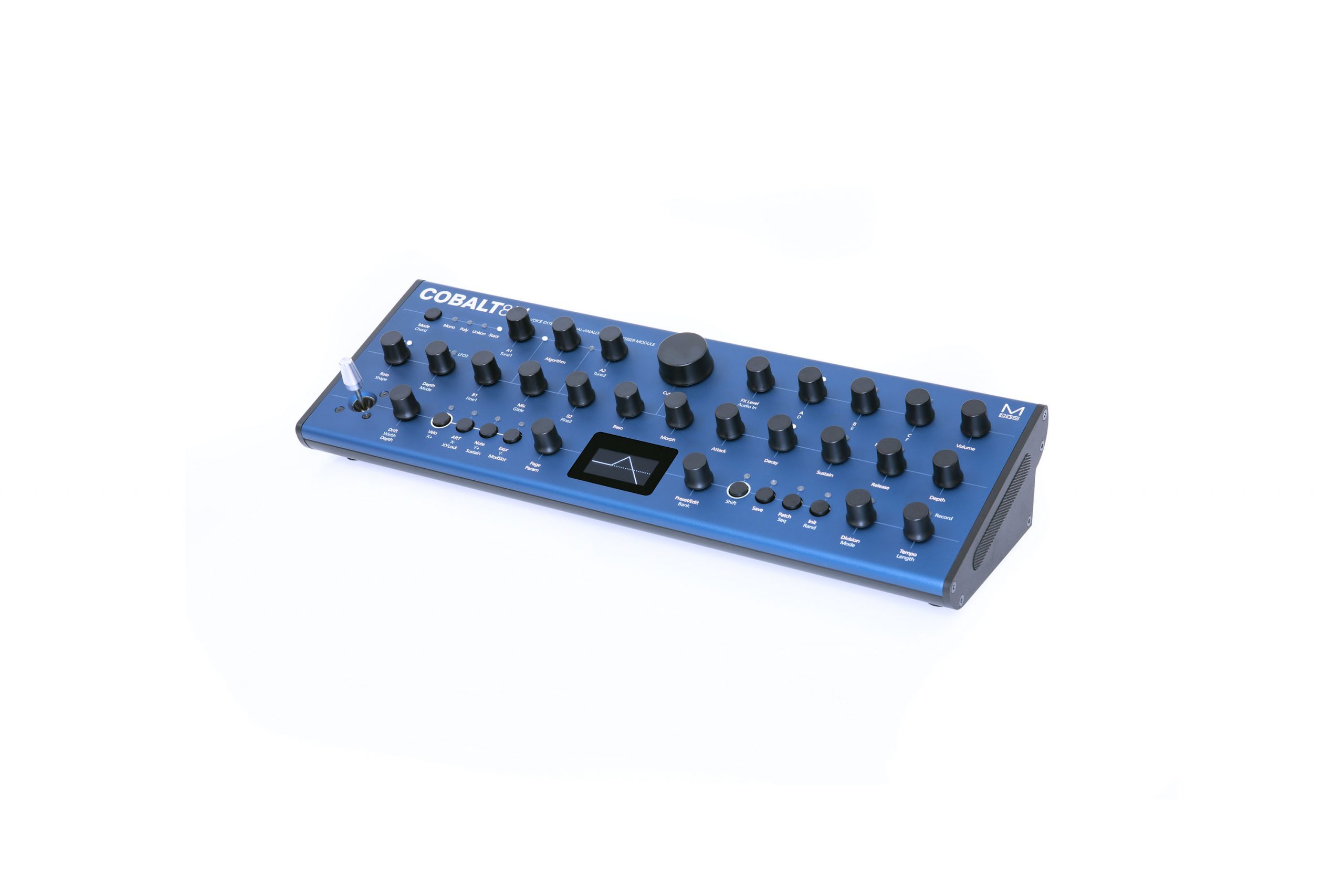
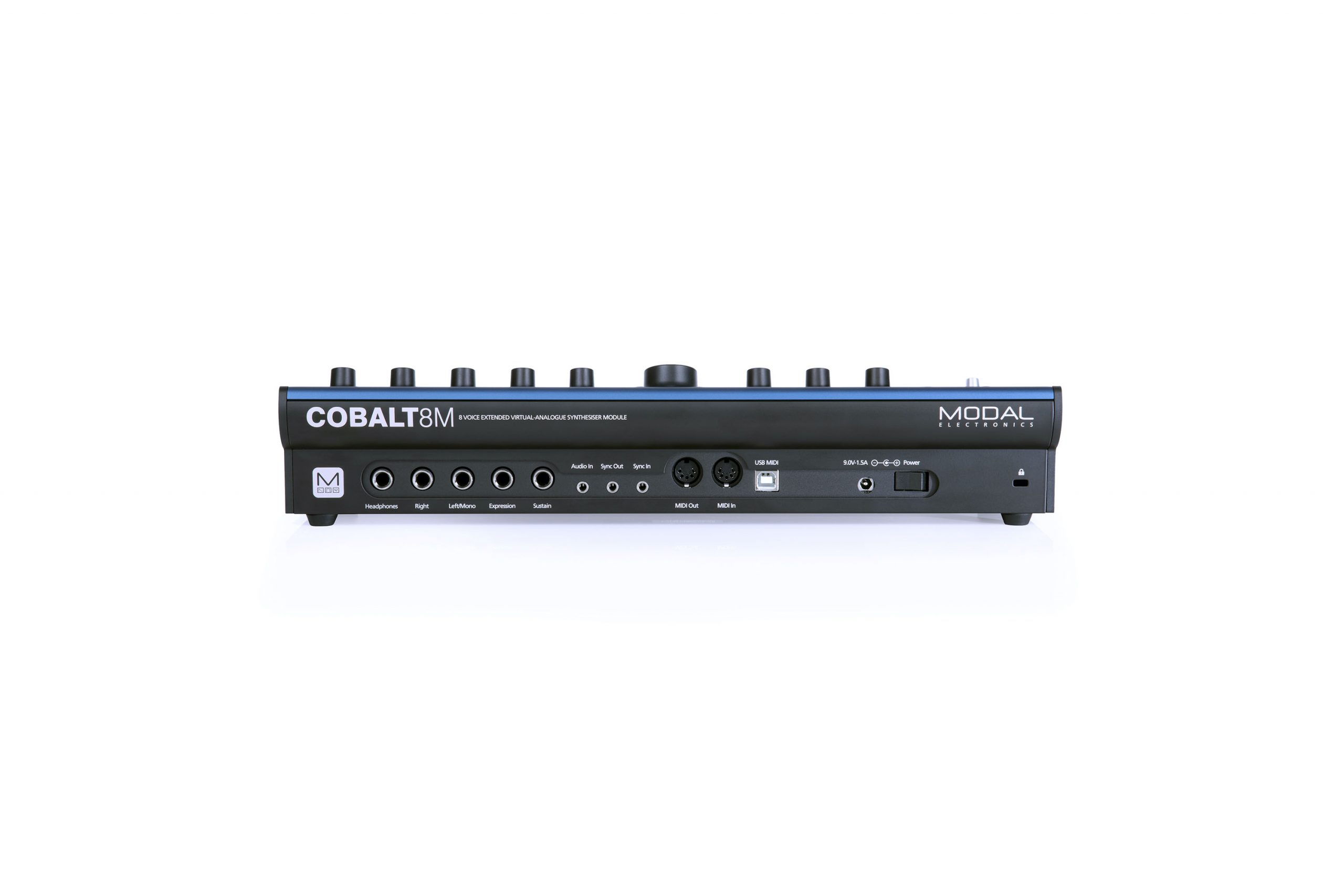

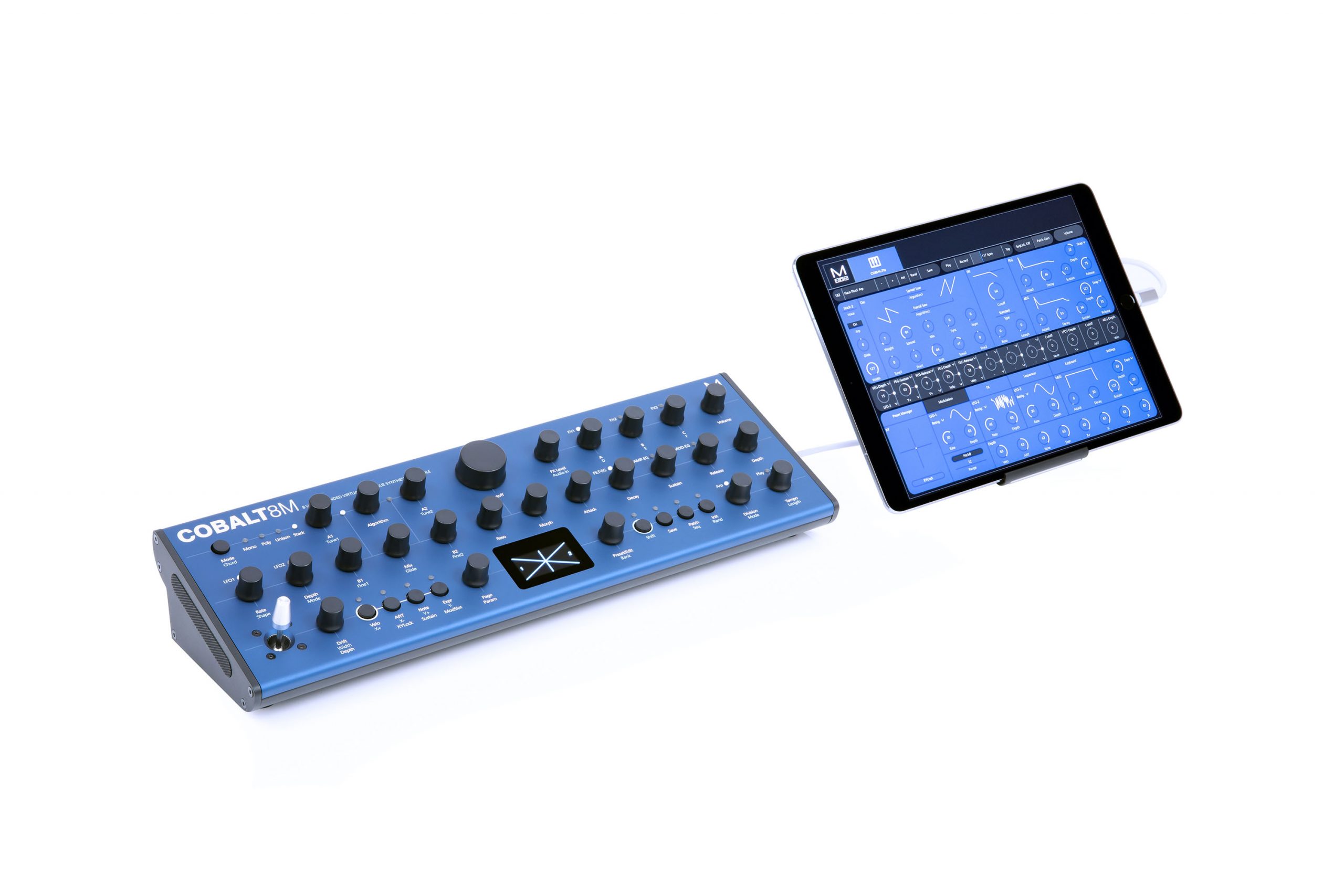

Play rich analogue-style sounds driven by COBALT8M’s Extended Virtual-Analogue Synthesis, combining traditional technology with modern synth features
Create your own signature sounds by harnessing the power of COBALT8M’s unique waveform architecture with 40 complex sophisticated algorithms and Modal’s incedible Filter section
Bring performance to a new level with MPE support, the integrated 512-note Realtime/Step Sequencer, 32-step programmable Arpeggiator and powerful Animation Lanes
Use the included rack brackets to mount COBALT8M into a 19” rack or use the synth on your producer desktop thanks to it sleek tabletop design
Integrate COBALT8M into your production and live performances with the full-size MIDI connections and the 3.5mm Sync Ins and Outs
Access all synthesiser functions and update COBALT8M via the free MODALapp, available on macOS, Windows, iOS, iPadOS, Android and AU/VST3

Demos
Videos
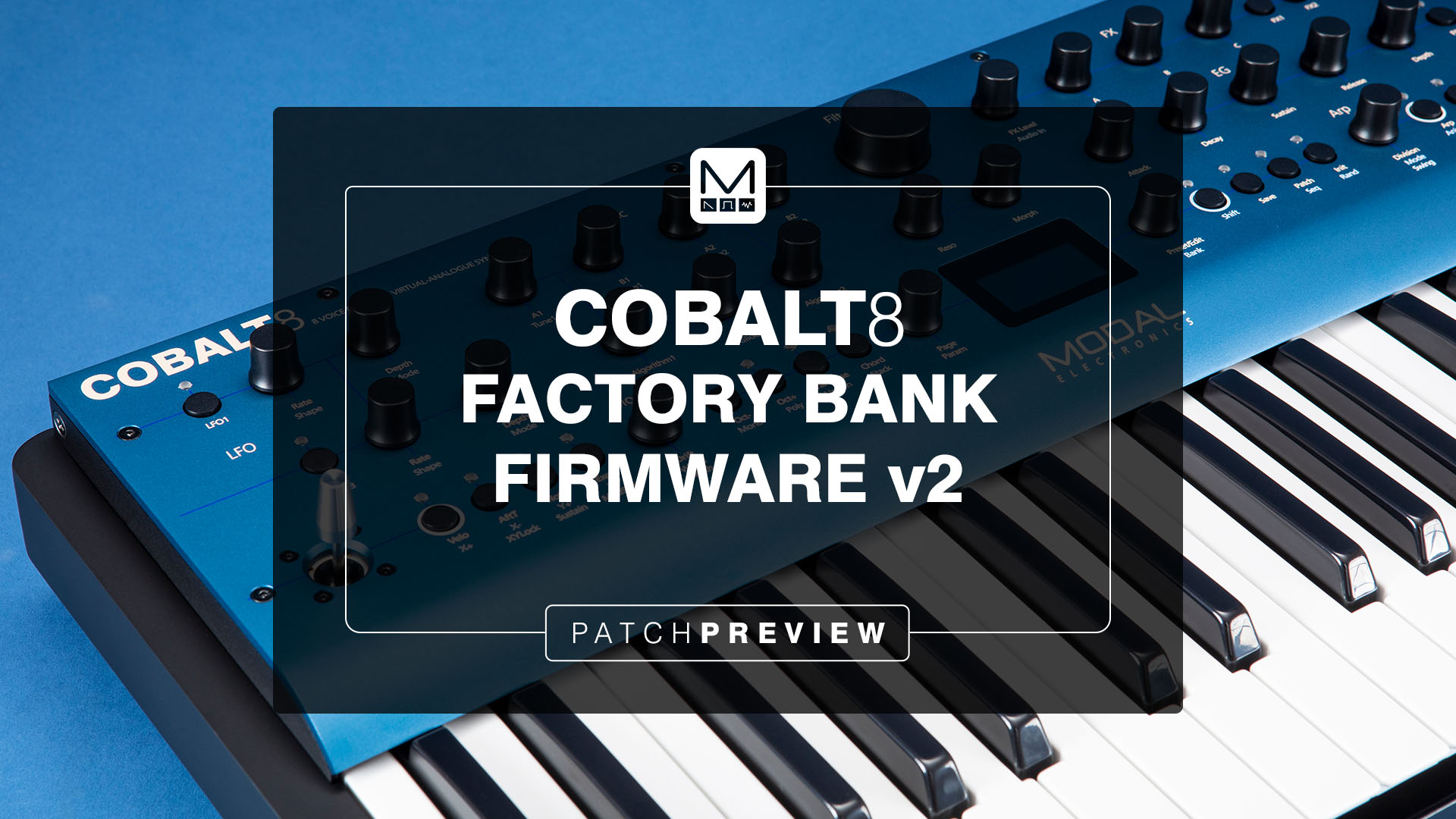
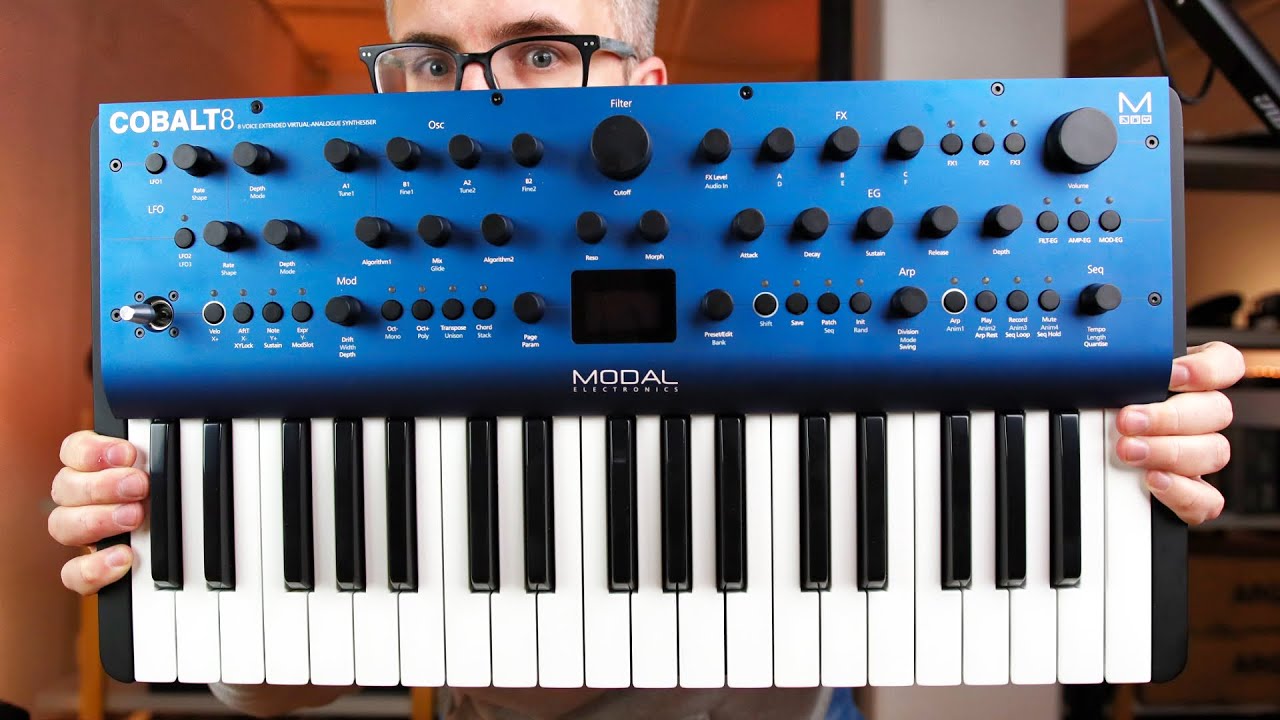


Algorithms
- VA Sweep: Sweep through sine, triangle, saw, square, pulse (with pulse width) (A), ability to detune the oscillators (or snap to musical intervals) using spread (B)
- VA Crushed: Sweep through sine, triangle and saw shapes (A) with real-time control over bit crushing (B)
- Spread Saw: Spread mode with increased oscillator count, ability to blend between the fundamental and detuned oscillators (A) and more comprehensive spread (B) options (e.g oct up + detuned)
- Spread Square: Spread mode with increased oscillator count, ability to blend between the fundamental and detuned oscillators (A) and more comprehensive spread (B) options (e.g oct up + detuned)
- Spread Triangle: Spread mode with increased oscillator count, ability to blend between the fundamental and detuned oscillators (A) and more comprehensive spread (B)options (e.g oct up + detuned)
- PWM: Classic Pulse Width Modulation with width control (A) and ability to detune the oscillators using spread (B)
- PWM Dual: PWM mode where as the width control (A) changes, the pulse width increases in the first cycle of the wave and decreases in the second cycle. Oscillators can be detuned using the spread (B) control
- PWM Triangle / Square: Alternating triangle and square waves with control over the width of the triangle portion (A) and an asymmetry control (B) that allows every second cycle to have a different triangle width (inverse) to the first
- PWM Saw Eraser: Wave with both a saw and PWM portion, with control over the ratio between the two portions (A) and the width of the PWM portion (B) relative to parameter A
- PWM Triangle Pinch: Triangle wave with pulse width modulation (A) and an asymmetry control (B) which allows every second cycle of the wave to have a different width to the first (can be wider or narrower)
- Hard Sync Saw: Classic hard sync with un-quantised ratio (A) that can be blended with a sub oscillator (B) one octave below the fundamental
- Hard Sync Square: Classic hard sync with un-quantised ratio (A) that can be blended with a sub oscillator (B) one octave below the fundamental
- Hard Sync Triangle: Classic hard sync with un-quantised ratio (A) that can be blended with a sub oscillator (B) one octave below the fundamental
- Fractal Saw: Complex sync with un-quantised control over ratio (A) and and an asymmetry control (B) that allows every second cycle of the wave to have a different sync ratio to the first
- Fractal Square: Complex sync with un-quantised control over ratio (A) and and an asymmetry control (B) that allows every second cycle of the wave to have a different sync ratio to the first
- Fractal Triangle: Complex sync with un-quantised control over ratio (A) and and an asymmetry control (B) that allows every second cycle of the wave to have a different sync ratio to the first
- Reverse Saw: Periodically reverses the direction of the waveform and changes the playback rate (A), asymmetry control (B) changes the period length (I.e the switch point within a cycle)
- Reverse Square: Periodically reverses the direction of the waveform and changes the playback rate (A), asymmetry control (B) changes the period length (I.e the switch point within a cycle)
- Reverse Triangle: Periodically reverses the direction of the waveform and changes the playback rate (A), asymmetry control (B) changes the period length (I.e the switch point within a cycle)
- Window Amp Sync: Applies amplitude modulation to a sine wave using a hard synced waveform. Features an un-quantised sync ratio control (A) and the ability to morph between multiple window shapes (B)
- Metal Saw: Creates ring modulation/amplitude modulation like effects by syncing a waveform to two separate signals, one at the base rate and one at the sync rate. Features un-quantised control over sync rate (A) and ability to balance between the base wave and the modulated signal (B)
- Metal Square: Creates ring modulation/amplitude modulation like effects by syncing a waveform to two separate signals, one at the base rate and one at the sync rate. Features un-quantised control over sync rate (A) and ability to balance between the base wave and the modulated signal (B)
- Metal Triangle: Creates ring modulation/amplitude modulation like effects by syncing a waveform to two separate signals, one at the base rate and one at the sync rate. Features un-quantised control over sync rate (A) and ability to balance between the base wave and the modulated signal (B)
- Ring Mod Saw: Ring mod applied to two saw waves, with quantised ratio control (A) that snaps through a series of useful ratios, and a fine control (B), which cross-fades between these ratios allowing precise control across the whole range
- Ring Mod Square: Ring mod applied to two square waves, with quantised ratio control (A) that snaps through a series of useful ratios, and a fine control (B), which cross-fades between these ratios allowing precise control across the whole range
- Ring Mod Triangle: Ring mod applied to two triangle waves, with quantised ratio control (A) that snaps through a series of useful ratios, and a fine control (B), which cross-fades between these ratios allowing precise control across the whole range
- Ring Mod Triangle / Square: Ring mod applied to a triangle and a square wave, with quantised ratio control (A) that snaps through a series of useful ratios, and a fine control (B), which cross-fades between these ratios allowing precise control across the whole range
- Ring Mod Saw / Square: Ring mod applied to a saw and square wave, with quantised ratio control (A) that snaps through a series of useful ratios, and a fine control (B), which cross-fades between these ratios allowing precise control across the whole range
- Ring Mod Saw / Triangle: Ring mod applied to a saw and triangle wave, with quantised ratio control (A) that snaps through a series of useful ratios, and a fine control (B), which cross-fades between these ratios allowing precise control across the whole range
- Chaos Saw: Un-quantised ring modulation (A) combined with randomisation (B)
- Chaos Square: Un-quantised ring modulation (A) combined with randomisation (B)
- Chaos Triangle: Un-quantised ring modulation (A) combined with randomisation (B)
- Fold Triangle: Triangle wave-folding (A) with DC offset (B)
- Filtered Noise: Noise generator combined with a morphable filter with full control over Cutoff (A) and Morph (B)
- NEW – FM Saw:Square: Frequency Modulation using a Sawtooth as the carrier and a Square as the modulator with full control over FM Depth (A) and Modulator Frequency Ratio (B)
- NEW – FM Square:Square: Frequency Modulation using a Square as both the carrier and modulator with full control over FM Depth (A) and Modulator Frequency Ratio (B)
- NEW – FM Tri:Square: Frequency Modulation using a Triangle as the carrier and a Square as the modulator with full control over FM Depth (A) and Modulator Frequency Ratio (B)
- NEW – Noise AM Saw: Sawtooth Wave amplitude modulated by a filtered noise source with full control over AM Depth (A) and Noise filter cutoff (B)
- NEW – Noise AM Square: Square Wave amplitude modulated by a filtered noise source with full control over AM Depth (A) and Noise filter cutoff (B)
- NEW – Noise AM Tri: Triangle Wave amplitude modulated by a filtered noise source with full control over AM Depth (A) and Noise filter cutoff (B)

Analogue Goodness
and so much more
Two independent oscillator groups with up to 4 oscillators each generate not only powerful virtual-analogue goodness, but like no other synthesiser before, 40 unique complex algorithms like Sync, Ring Modulation, Waveform Morphing, and many more are available to increase the creative options for new-generation synth sounds. Each Algorithm has a simple-to-use pair of controls selected to suit the particular algorithm or character, providing musicians the power of traditionally complex oscillator modulations or processes spontaneously.
Filter Extravaganza
COBALT8M’s filter section contains a wide selection of over 30 different filter types to tastefully tailor the sonic content of the algorithms mix. Our advanced morphable 2-Pole-State Variable Filters and 4-Pole Ladder Filters provide incredible flexibility for unconventional as well as classic synth sounds. Various Lowpass, Bandpass and Highpass Ladder Filters with drive, combinations of traditional filter types with Notch characteristics, and much more unlock even more classic tones and expand COBALT8M’s experimental capabilities with the more complex filter outputs to create sounds that no one could imagine before.
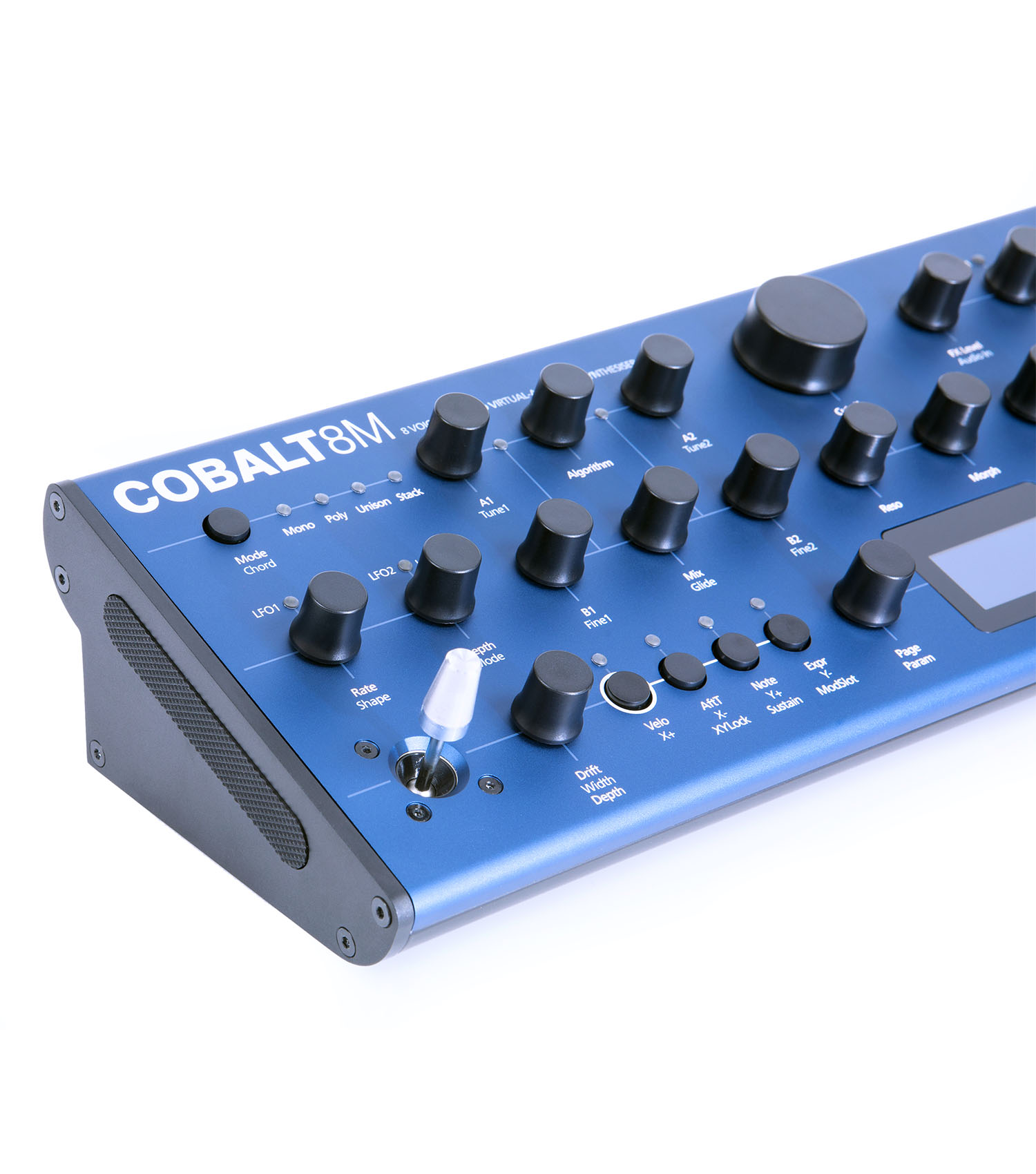
Filter Types
- 4-Pole Morphable Lowpass Ladder Filter
- Balanced 4-Pole Morphable Lowpass Ladder Filter
- Morphable Phasing Filter
- Morphable Notch Filter
- State Variable Filter with BP
- State Variable Filter with Notch
- 4 pole Lowpass Ladder (with drive)
- 3 pole Lowpass Ladder (with drive)
- 2 pole Lowpass Ladder (with drive)
- 1 pole Lowpass Ladder (with drive)
- 4 pole Highpass Ladder (with drive)
- 3 pole Highpass Ladder (with drive)
- 2 pole Highpass Ladder (with drive)
- 1 pole Highpass Ladder (with drive)
- 4 pole bandpass Ladder (12dB Lp /12dB Hp) (with drive)
- 2 pole Bandpass Ladder (6dB Lp / 6dB Hp) (with drive)
- 3 pole Bandpass Ladder (6dB Lp / 12dB Hp) (with drive)
- 3 pole Bandpass Ladder (12dB Lp / 6dB Hp) (with drive)
- 4 pole Bandpass Ladder (6dB Lp / 18dB Hp) (with drive)
- 4 pole Bandpass Ladder (18dB Lp / 6dB Hp) (with drive)
- Notch Ladder (with drive)
- Notch Ladder Alt (with drive)
- Lowpass Ladder with Notch (with drive)
- Lowpass Ladder with Notch Alt (with drive) – notch closes with resonance
- Lowpass Ladder with Notch and Resonance (with drive)
- Bandpass Ladder with Notch (with drive) – notch closes with resonance
- Bandpass Ladder with Notch and Resonance (with drive)
- Phaser Ladder (with drive)
- Highpass Ladder with Notch (with drive) – notch closes with resonance
- Highpass Ladder with Notch and Resonance (with drive)
- Peaking Filter (with drive)

Shape your sound
Three flexible audio-rate (2 x polyphonic) LFOs can be routed to a massive amount of destinations using the modulation matrix and sync to internal or external tempo. Three dedicated envelopes for the filter, amp and modulation allow excessive control over dynamics and expression. Switchable envelope types provide greater options to tailor the envelopes for specific sound purposes. COBALT8M’s sophisticated 12-slot modulation matrix supports easy assignments of complex modulation routes to keep the sound evolving. Four common modulation routings are pre-set here to free up space for more exciting ideas.
Next generation
Sequencer and Arp
The integrated 512-note Realtime / Step Sequencer with four powerful Animation Lanes invites to compose massive and complex melodic patterns. The polyphonic 64-note step sequencer mode enables easy step input for note and animation values. Multiple sequencer trigger modes coupled with the powerful onboard arpeggiator (programmable up to 32 steps) and performance features such as Chord Hold, Inversions, Transpose, Sustain Latch.


Rugged and functional enclosure
COBALT8M’s rugged steel and aluminium enclosure underlines the synth’s professional approach. The desktop design fits on every producer’s table, and Included brackets help to mount COBALT8M into a live or studio rack. For direct access of the parameters, COBALT8M features 13 switched encoders, 13 encoders, 9 buttons and an X/Y joystick for pitch or modulation. MPE support offers new ways of creative expression for sophisticated performers.
Polish your patches
with studio-grade FX
Reshape your sounds completely with the onboard stereo effects engine. COBALT8M comes with a 3-slot FX engine with in-depth FX programming. To polish the sound, a total of 26 FX algorithms add character and depth, including rich Reverbs, warm Chorus effects, swirling Phasers and Flangers, Tremolo, LoFi, Rotary, wide Delays, Equaliser, Compressor and more.

Looking to connect
Set to be played in any synth environment, COBALT8M comes with all physical connections required. Control the synth using USB, monitor with headphones or using the dedicated line outputs, sync with external gear using the full-size MIDI in and out or the 3.5 mm Sync in or outputs and take control of your sound using the built-in Sustain and Expression inputs. By poly-chaining any two COBALT8 devices, the amount of voices is easily doubled to 16 voices and 128 oscillators.

Access all Areas
There is plenty of room to store patch, effects and sequence creations. Out of the box, 300 of the total 500 patches are filled with factory patch banks, carefully programmed by some of the most accomplished sound designers of the world. One hundred customised effects configurations and sequences can be stored as well to be applied to any sound while performing.
Our Modal Patch library hosts hundreds of sound banks and individual sounds, spanning from classic synth tones from the past to new contemporary textures. All sound banks in our library are available for free and can be easily imported through our free MODALapp.


From the press
Attack Magazine – “If you’re a fan of analogue with a hankering for something a little different, COBALT8 doesn’t take long to win your heart.”
Sonicstate – “It is quite a pleasurable patch creation experience.”
Synthanatomy – “It is clear that it does not want to emulate an analog synth from the past. It rather pushes the analog modelling technologies forward.”
Failed Muso – “MODAL have yet another winner on their hands and I will truly miss the instant fun I get from it when I have to send this back.”
Music Radar – “Another brilliantly unique-sounding Modal machine! Very flexible for its price and a powerful editor plus MPE give it futuristic appeal.”
Free MODALapp for
immersive sound programming sessions
The free MODALapp brings the comfort of screen-based editing on your computer or mobile device. Available as a standalone app for macOS, Windows, iOS, iPadOS or Android systems and in VST3 and AU plug-in formats it is the perfect companion for synth enthusiasts looking to deep dive to all sound forming and performance parameters to create their own signature sounds, and to backup and manage patches and sequences.

Specification
Polyphony
True 8 voice polyphonic
MPE
Supports MPE-compatible MIDI controllers, allowing you to apply polyphonic control and expression to individual notes
Oscillators
64 high-resolution virtual-analogue oscillators, up to 8 per voice
Two independent and self-contained oscillator groups with sine, pulse, triangle, sawtooth waveforms, 40 different algorithms including: complex analogue synthesis techniques, built-in crossmodulation (SYNC, RM, and many more), PWM, smooth morphing between VA waves, bit crushing, filtered noise.
Extended Oscillator Drift
Algorithms
- VA Sweep: Sweep through sine, triangle, saw, square, pulse (with pulse width) (A), ability to detune the oscillators (or snap to musical intervals) using spread (B)
- VA Crushed: Sweep through sine, triangle and saw shapes (A) with real-time control over bit crushing (B)
- Spread Saw: Spread mode with increased oscillator count, ability to blend between the fundamental and detuned oscillators (A) and more comprehensive spread (B) options (e.g oct up + detuned)
- Spread Square: Spread mode with increased oscillator count, ability to blend between the fundamental and detuned oscillators (A) and more comprehensive spread (B) options (e.g oct up + detuned)
- Spread Triangle: Spread mode with increased oscillator count, ability to blend between the fundamental and detuned oscillators (A) and more comprehensive spread (B)options (e.g oct up + detuned)
- PWM: Classic Pulse Width Modulation with width control (A) and ability to detune the oscillators using spread (B)
- PWM Dual: PWM mode where as the width control (A) changes, the pulse width increases in the first cycle of the wave and decreases in the second cycle. Oscillators can be detuned using the spread (B) control
- PWM Triangle / Square: Alternating triangle and square waves with control over the width of the triangle portion (A) and an asymmetry control (B) that allows every second cycle to have a different triangle width (inverse) to the first
- PWM Saw Eraser: Wave with both a saw and PWM portion, with control over the ratio between the two portions (A) and the width of the PWM portion (B) relative to parameter A
- PWM Triangle Pinch: Triangle wave with pulse width modulation (A) and an asymmetry control (B) which allows every second cycle of the wave to have a different width to the first (can be wider or narrower)
- Hard Sync Saw: Classic hard sync with un-quantised ratio (A) that can be blended with a sub oscillator (B) one octave below the fundamental
- Hard Sync Square: Classic hard sync with un-quantised ratio (A) that can be blended with a sub oscillator (B) one octave below the fundamental
- Hard Sync Triangle: Classic hard sync with un-quantised ratio (A) that can be blended with a sub oscillator (B) one octave below the fundamental
- Fractal Saw: Complex sync with un-quantised control over ratio (A) and and an asymmetry control (B) that allows every second cycle of the wave to have a different sync ratio to the first
- Fractal Square: Complex sync with un-quantised control over ratio (A) and and an asymmetry control (B) that allows every second cycle of the wave to have a different sync ratio to the first
- Fractal Triangle: Complex sync with un-quantised control over ratio (A) and and an asymmetry control (B) that allows every second cycle of the wave to have a different sync ratio to the first
- Reverse Saw: Periodically reverses the direction of the waveform and changes the playback rate (A), asymmetry control (B) changes the period length (I.e the switch point within a cycle)
- Reverse Square: Periodically reverses the direction of the waveform and changes the playback rate (A), asymmetry control (B) changes the period length (I.e the switch point within a cycle)
- Reverse Triangle: Periodically reverses the direction of the waveform and changes the playback rate (A), asymmetry control (B) changes the period length (I.e the switch point within a cycle)
- Window Amp Sync: Applies amplitude modulation to a sine wave using a hard synced waveform. Features an un-quantised sync ratio control (A) and the ability to morph between multiple window shapes (B)
- Metal Saw: Creates ring modulation/amplitude modulation like effects by syncing a waveform to two separate signals, one at the base rate and one at the sync rate. Features un-quantised control over sync rate (A) and ability to balance between the base wave and the modulated signal (B)
- Metal Square: Creates ring modulation/amplitude modulation like effects by syncing a waveform to two separate signals, one at the base rate and one at the sync rate. Features un-quantised control over sync rate (A) and ability to balance between the base wave and the modulated signal (B)
- Metal Triangle: Creates ring modulation/amplitude modulation like effects by syncing a waveform to two separate signals, one at the base rate and one at the sync rate. Features un-quantised control over sync rate (A) and ability to balance between the base wave and the modulated signal (B)
- Ring Mod Saw: Ring mod applied to two saw waves, with quantised ratio control (A) that snaps through a series of useful ratios, and a fine control (B), which cross-fades between these ratios allowing precise control across the whole range
- Ring Mod Square: Ring mod applied to two square waves, with quantised ratio control (A) that snaps through a series of useful ratios, and a fine control (B), which cross-fades between these ratios allowing precise control across the whole range
- Ring Mod Triangle: Ring mod applied to two triangle waves, with quantised ratio control (A) that snaps through a series of useful ratios, and a fine control (B), which cross-fades between these ratios allowing precise control across the whole range
- Ring Mod Triangle / Square: Ring mod applied to a triangle and a square wave, with quantised ratio control (A) that snaps through a series of useful ratios, and a fine control (B), which cross-fades between these ratios allowing precise control across the whole range
- Ring Mod Saw / Square: Ring mod applied to a saw and square wave, with quantised ratio control (A) that snaps through a series of useful ratios, and a fine control (B), which cross-fades between these ratios allowing precise control across the whole range
- Ring Mod Saw / Triangle: Ring mod applied to a saw and triangle wave, with quantised ratio control (A) that snaps through a series of useful ratios, and a fine control (B), which cross-fades between these ratios allowing precise control across the whole range
- Chaos Saw: Un-quantised ring modulation (A) combined with randomisation (B)
- Chaos Square: Un-quantised ring modulation (A) combined with randomisation (B)
- Chaos Triangle: Un-quantised ring modulation (A) combined with randomisation (B)
- Fold Triangle: Triangle wave-folding (A) with DC offset (B)
- Filtered Noise: Noise generator combined with a morphable filter with full control over Cutoff (A) and Morph (B)
- NEW – FM Saw:Square: Frequency Modulation using a Sawtooth as the carrier and a Square as the modulator with full control over FM Depth (A) and Modulator Frequency Ratio (B)
- NEW – FM Square:Square: Frequency Modulation using a Square as both the carrier and modulator with full control over FM Depth (A) and Modulator Frequency Ratio (B)
- NEW – FM Tri:Square: Frequency Modulation using a Triangle as the carrier and a Square as the modulator with full control over FM Depth (A) and Modulator Frequency Ratio (B)
- NEW – Noise AM Saw: Sawtooth Wave amplitude modulated by a filtered noise source with full control over AM Depth (A) and Noise filter cutoff (B)
- NEW – Noise AM Square: Square Wave amplitude modulated by a filtered noise source with full control over AM Depth (A) and Noise filter cutoff (B)
- NEW – Noise AM Tri: Triangle Wave amplitude modulated by a filtered noise source with full control over AM Depth (A) and Noise filter cutoff (B)
Filter
31 resonant Filter types including morphable and static filters
Cutoff Scaling with three distinctive modes
Filter Types
- 4-Pole Morphable Lowpass Ladder Filter
- Balanced 4-Pole Morphable Lowpass Ladder Filter
- Morphable Phasing Filter
- Morphable Notch Filter
- State Variable Filter with BP
- State Variable Filter with Notch
- 4 pole Lowpass Ladder (with drive)
- 3 pole Lowpass Ladder (with drive)
- 2 pole Lowpass Ladder (with drive)
- 1 pole Lowpass Ladder (with drive)
- 4 pole Highpass Ladder (with drive)
- 3 pole Highpass Ladder (with drive)
- 2 pole Highpass Ladder (with drive)
- 1 pole Highpass Ladder (with drive)
- 4 pole bandpass Ladder (12dB Lp /12dB Hp) (with drive)
- 2 pole Bandpass Ladder (6dB Lp / 6dB Hp) (with drive)
- 3 pole Bandpass Ladder (6dB Lp / 12dB Hp) (with drive)
- 3 pole Bandpass Ladder (12dB Lp / 6dB Hp) (with drive)
- 4 pole Bandpass Ladder (6dB Lp / 18dB Hp) (with drive)
- 4 pole Bandpass Ladder (18dB Lp / 6dB Hp) (with drive)
- Notch Ladder (with drive)
- Notch Ladder Alt (with drive)
- Lowpass Ladder with Notch (with drive)
- Lowpass Ladder with Notch Alt (with drive) – notch closes with resonance
- Lowpass Ladder with Notch and Resonance (with drive)
- Bandpass Ladder with Notch (with drive) – notch closes with resonance
- Bandpass Ladder with Notch and Resonance (with drive)
- Phaser Ladder (with drive)
- Highpass Ladder with Notch (with drive) – notch closes with resonance
- Highpass Ladder with Notch and Resonance (with drive)
- Peaking Filter (with drive)
Modulation
Three dedicated envelope generators for AMP, MOD and FILTER that can be accessed independently or all three simultaneously including negative (reverse) versions for MOD and FILTER ENVs
Three audio-rate LFO’s with tempo sync (two poly, one global) with seven different shapes
Eight assignable modulation slots and four additional fixed modulation routings for common assignments with 12 modulation sources and 55 modulation destinations
Sequencer and Arpeggiator
Polyphonic Real-time sequencer with 512 notes and four recordable/editable parameter animations (Delay FX, LFO’s, sequencer and arpeggiator can be either clocked internally or externally)
Polyphonic Step Sequencer with 64 steps, 8 notes per step, 4 lanes of Parameter-Lock style animation, Step Input mode, multiple playback modes including gate modes and rest function
Built-In sophisticated programmable arpeggiator of 32 steps with rest capability with up to 2048 steps before repeating
FX
Three incredibly powerful independent and user-configurable stereo FX engines for 26 Effects algorithms, incl. Drive, Chorus, Phaser, Flanger, Tremolo, LoFi, Rotary, Stereo Delay, Ping-Pong Delay, X-Over Delay and Reverb.
User Memory
500 patch memories, all fully editable and ships with 300 factory programs
100 sequencer presets that can be linked to any patch for quickly loading arrangements
100 FX presets
4 Quick Recall slots accessible from the panel for quickly loading your favourite patches
Controls and Performance
13 switched encoders, 13 encoders, 9 buttons
4-axis joystick that can be assigned to a huge range of modulation destinations and virtually ‘locked’ when desired
Multiple voice modes, Mono, Poly, Unison 2, unison 4, unison 8, Stack 2 and Stack 4
Glide/Portamento with both legato and staccato modes
Chord Invert control to easily create chord inversions and variation
Inputs and Outputs
6.35 mm / 1/4″ TS dual-mono line outputs
6.35 mm / 1/4″ TRS headphone output
3.5 mm / 1/8″ TRS stereo audio input
MIDI DIN In and Out
3.5 mm / 1/8″ TS Analogue clock sync In and Out
Class compliant MIDI over USB connection
6.35 mm / 1/4″ TRS expression pedal input
6.35 mm / 1/4″ TS sustain pedal input
Enclosure and Display
Tabletop-style enclosure, brackets for 19″ 3U rackmount included (requires 1U free space above or right-angled connectors)
1.54-inch large OLED display for instant visual feedback at all times of playing/editing
Power
Power: DC-9.0V – 1.5A centre-positive
Editor Software
Free MODALapp software editor available for macOS, Windows, iOS and Android
MODALapp can also be run within your Digital Audio Workstation (DAW), with VST3 and AU versions available
General
Dimensions (L x W x H): 384 x 127 x 81 mm / 15.1″ x 5″ x 3.2″
Weight: 2.1 kg / 4.6 lbs
Sounds
Tips & Tricks
Firmware
Firmware v2.1
Please update your COBALT8M via the standalone MODALapp
Improvements:
- Updated the Note > Cutoff behaviour when using the Relative and Bipolar Filter Cutoff Scaling modes so that it tracks portamento / glide and pitch bend
- Added a panel shortcut for the Osc Free Run parameter – hold the ‘Patch’ button and turn the Osc2 Tune control (the ‘A2/Tune2’ encoder)
- Improved the behaviour / feel of the encoder when controlling the Cutoff Scaling parameter
Fixes:
- Fixed an arpeggiator delay / latency issue introduced in Firmware V2
- Fixed arpeggiator hanging notes issues potentially seen when using long divisions and gate lengths
- Fixed an arpeggiator chord mode issue where pressed notes may not all be added to the arp straight away
- Fixed very rare crash when sending certain tempo values from external MIDI
Features:
- Added 14 new FX including a new reverb algorithm:
- Reverb V2
- Phaser V2
- Unisoniser
- Compressor
- Three Band EQ
- Mono Drive (Hard Clip)
- Mono Drive (Soft Clip)
- Mono Drive (Rectify)
- Mono Drive (Fold)
- Stereo Drive (Hard Clip)
- Stereo Drive (Soft Clip)
- Stereo Drive (Rectify)
- Stereo Drive (Fold)
- Utility
- 27 New Filter Types: 2 morphable, 25 non-morphable where the ‘Morph’ parameter instead becomes ‘Drive’.
- State Variable Filter with BP
- State Variable Filter with Notch
- 4 pole Lowpass Ladder (with drive)
- 3 pole Lowpass Ladder (with drive)
- 2 pole Lowpass Ladder (with drive)
- 1 pole Lowpass Ladder (with drive)
- 4 pole Highpass Ladder (with drive)
- 3 pole Highpass Ladder (with drive)
- 2 pole Highpass Ladder (with drive)
- 1 pole Highpass Ladder (with drive)
- 4 pole bandpass Ladder (12dB Lp /12dB Hp) (with drive)
- 2 pole Bandpass Ladder (6dB Lp / 6dB Hp) (with drive)
- 3 pole Bandpass Ladder (6dB Lp / 12dB Hp) (with drive)
- 3 pole Bandpass Ladder (12dB Lp / 6dB Hp) (with drive)
- 4 pole Bandpass Ladder (6dB Lp / 18dB Hp) (with drive)
- 4 pole Bandpass Ladder (18dB Lp / 6dB Hp) (with drive)
- Notch Ladder (with drive)
- Notch Ladder Alt (with drive)
- Lowpass Ladder with Notch (with drive)
- Lowpass Ladder with Notch Alt (with drive) – notch closes with resonance
- Lowpass Ladder with Notch and Resonance (with drive)
- Bandpass Ladder with Notch (with drive) – notch closes with resonance
- Bandpass Ladder with Notch and Resonance (with drive)
- Phaser Ladder (with drive)
- Highpass Ladder with Notch (with drive) – notch closes with resonance
- Highpass Ladder with Notch and Resonance (with drive)
- Peaking Filter (with drive)
- Vintage Parameter – Emulating the behaviour of vintage synths by introducing variation between the voices
- Osc Free Run – Emulating the behaviour of analogue oscillators by allowing them to run freely
- 7 new arpeggiator directions:
- Chord
- Pendulum 2 – Repeats the last note when reversing direction
- N-Pendulum 2 – Pendulum 2 in note number order
- Reverse Pendulum – A reverse version of Pendulum
- N-Reverse Pendulum – A reverse version of N-Pendulum
- Reverse Pendulum 2 – A reverse version of Pendulum 2
- N-Reverse Pendulum 2 – A reverse version of N-Pendulum 2
- Added a “Cutoff Scaling” patch parameter for improved filter cutoff behaviour with the following modes:
- Legacy – The existing cutoff control scaling curve and note-to-cutoff tracking behaviour
- Relative – A new cutoff control scaling curve that is more balanced and changes the note-to-cutoff tracking to behave more closely to analogue synths. In this mode note-to-cutoff tracks best when the cutoff control is at 0.
- Bipolar – The same cutoff control scaling curve as the ‘Relative’ mode, except in this mode note-to-cutoff tracks best when the cutoff control is at 64.
Improvements:
- Improved internal gain staging for increased output volume in most cases
- Improved the screen’s filter graph / parameter pages in the following ways:
- Improved the graph to be a more accurate representation of the filter
- The Type parameter page now displays both the graph and text value
- Improved Audio In sound quality
Fixes:
- Fixed issue with the tempo-synced delay times
- Fixed a potential arpeggiator note ordering issue when playing arps with an arp octave value of 2 or more
- Fixed a potential arpeggiator note ordering issue when playing arp patterns using a pendulum direction mode
- Fixed issue where the first loop of the arpeggiator sequence may not contain all pressed notes when using the ‘backwards’ direction mode
Fixes:
- Fixed FX preset indexing issue introduced in v1.3
- Fixed FX parameters not always being updated for polychain slaves
Features:
- New Chorus FX (“Chorus (v2)”), introduced in COBALT5S, added to the COBALT8 series
Improvements:
- Fixed sequencer name desync issue
Improvements:
- Improved USB MIDI Connectivity on Mac OS Big Sur
- Enhanced reliability for large data transfers with MODALapp
Features:
- 6 new oscillator algorithms (Noise AM and Square FM types)
- Added ‘Master’ clock mode that always sends out MIDI clock
Improvements:
- Improved arpeggiator sync when working with external sequencers
- Improved expression pedal behaviour
- Improved LFO1 sync when clocked from external MIDI
Fixes:
- Removed some modulation assignment options that don’t make sense
- Fixed some re-trigger issues with the S+H shape on LFO1
- Fixed issue where an external CC 0 (bank) message would cause the screen to switch to the ‘play’ page, if screen switching is enabled for external MIDI messages.
- Fixed Tri Noise screen display glitches
- Fixed issue where vibrato assignments could cause oscillator pitch offsets
- Fixed an edge case when loading a step sequence with 0 steps
- Fixed Y+ to LFO1 assignment not always working as expected
- Fixed app sync of XY lock parameter
Software Editor
The free MODALapp brings the comfort of screen-based editing on your computer or mobile device. Available as standalone app for macOS, Windows, iOS, iPadOS or Android systems and in VST3 and AU plug-in formats it is the perfect companion for synth enthusiasts looking to deep-dive to all soundforming and performance parameters to create their own signature sounds.





